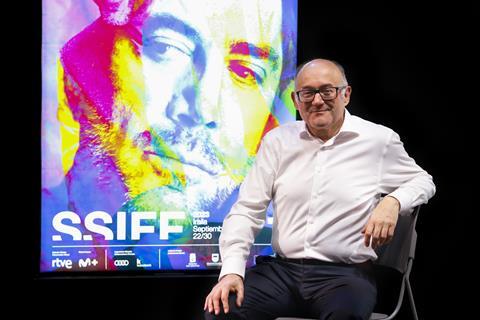
The San Sebastian International Film Festival opens today, Friday September 22, and festival director José Luis Rebordinos takes a clear pride in the role of the festival as showcase for new talent. He points to the strong presence of first-time directors in the official selection, the New Directors section and the works in progress projects in the industry activities.
The festival is also celebrating two veteran filmmakers with the honorary Donostia award: Spanish director Victor Erice returns 50 years after he won the Golden Shell with The Spirit Of The Beehive, and Japanese animation master Hiyao Miyazaki is in town with what is probably his last film, The Boy And The Heron, which has its European premiere as the festival’s opening film tonight.
Rebordinos talks to Screen about the gender parity the selection committee has achieved in the main competition this year, the impact of the US writers’ and actors’ strikes on putting together the festival and the key role San Sebastian plays in bringing together the industries in Europe and Latin America.
The 71st edition of the festival runs until September 30, closing with the European premiere of xx.
What stands out for you in this year’s official selection?
We always aim for a balance of theme and style. If topics are tackled more persistently or particular traits of the competitive selection stand out, that is something we tend to notice afterwards, once we have chosen the films and get a sense of the broad picture.
This year, for example, the three Spanish films in competition are directed by women (Isabel Coixet’s Un Amor; Isabel Herguera’s Sultana’s Dream and Jaione Camborda’s The Rye Horn) in tune with the powerful and growing presence of women filmmakers in the Spanish industry, something that has also left its mark in other international film festivals.
There are also three animation films in the official selection: Hayao Miyazaki’s The Boy And The Heron, opening the festival and Fernando Trueba and Javier Mariscal’s They Shot The Piano Player, both out of competition, as well as Isabel Herguera’s Sultana’s Dream in competition. We had never had so many animation films in this section, a genre that is also present for the first time in the European Work-in-Progress section with one of the projects selected.
In terms of themes, we have films tackling the inner world of family, but also the idea of confronting history from different angles, such as Robin Campillo’s Red Island, in competition, dealing with colonialism, and Ulises de la Orden’s documentary The Trial [about the trial of the Military Juntas of the Argentinian dictatorship accused of crimes against humanity] in the Zabaltegi-Tabakalera section. This is a film that takes a non-fiction approach to the events that (Santiago Mitre’s) Argentina 1985 dealt with last year. And there is also No Me llame Ternera (Don’t Call Me Ternera), by Jordi Évole and Màrius Sáchez in the Made in Spain section.
There has been some controversy in Spain over the inclusion of No Me llame Ternera (Don’t Call Me Ternera), to the point the festival had to release a statement explaining its selection. Could you explain the context and reasons for programming the film?
The film is basically an interview with Josu Urrutikoetxea [whose nickname was Josu Ternera] one of the heads of ETA for decades. ETA [the Basque terrorist group] ceased to exist years ago but wounds are still fresh and the controversy stems from the fact that the documentary interviews Ternera, responsible for many murders. We understand that. But we also want to make clear that this film neither justifies nor whitewashes ETA. The festival would never screen a film with such a premise. This film does the opposite, in my view. We think it’s important that such a film is seen and discussed. The problem is when people feel inclined to censor content before it’s seen.
You must be happy that of the 16 films in competition this year, eight are directed by women or co-directed by women.
We have never applied quotas when choosing finished films but have supported them in work-in-progress and in project stages and it’s great to see things are finally changing in terms of equality in the industry.

What are the strong points of San Sebastian as a stop-off on the international festival circuit?
We are a key festival for Spanish and Latin American cinema, a bridge to Europe that operates in both directions - for European cinema to reach Latin America too.
A distinctive trait is our desire to support new talent, working all year round, hand-in-hand with a project residency programme [Ikusmira Berriak] a film institute and a film school [Elías Querejeta Zine Eskol]..
We also, we have first and second films included in the official selection [this year 10 titles out of and 21] alongside well-known and established filmmakers and a whole section devoted to New Directors. Spotting new talents is truly a vocation for us, knowing these will probably have their latter films in festivals such as Cannes. Two titles in competition, Jaione Camborda’s The Rye Horn and Raven Jackson’s All Dirt Roads Taste Of Salt, were in our residency programme.
In general we don’t like the idea of competing with other festivals too much. Sections like Pearls from other festivals or Zabaltegi, are rhappy to harvest some of the best films of the year that have premiered elsewhere.
On the industry side of the festival, the festival is hosting the second Creative Investors’ Conference in the frame of Spanish Screenings: Financing & Tech. What is the strategic relevance of this initiative for San Sebastian?
It brings the type of investor that did not use to attend the festival before. They will discuss the impact of new technologies and their perspective is key in the landscape of a changing industry. The big names also draw the attendance of other players and it’s great for generating networking opportunities. As for the future, the conference depends on European funds channelled by the Spanish national film body (ICAA) destined to cover two years. This means we will have to look for funding for next year but we hope to ensure its continuity.
What has been the impact of the ongoing strike in Hollywood in terms of the programme and stars’ attendance at the festival?
It has meant longer hours trying to figure out how to deal with it, fully understanding that it’s a complex situation. We have missed the chance to have some Hollywood stars that had previously been confirmed but the programme is exactly what we intended it to be. Some titles will have fewer talents attending, of course. And we also had to make some changes in the jury. We are a smaller festival than Venice so the fact that there are fewer stars on the red carpet is lesser too. That said, I think Venice dealt with it very well.






![The Brightest SunScreen[Courtesy HKIFF]](https://d1nslcd7m2225b.cloudfront.net/Pictures/274x183/3/5/0/1448350_thebrightestsunscreencourtesyhkiff_312678.jpg)


















No comments yet